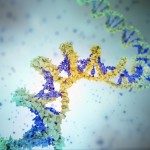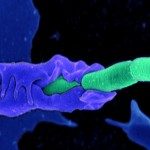Link to Pubmed [PMID] – 26884428
MBio 2016 Feb;7(1):e02183-15
UNLABELLED: Community-acquired methicillin-resistant Staphylococcus aureus (CA-MRSA) was recognized worldwide during the 1990s; in less than a decade, several genetically distinct CA-MRSA lineages carrying Panton-Valentine leukocidin genes have emerged on every continent. Most notably, in the United States, the sequence type 18-IV (ST8-IV) clone known as USA300 has become highly prevalent, outcompeting methicillin-susceptible S. aureus (MSSA) and other MRSA strains in both community and hospital settings. CA-MRSA bacteria are much less prevalent in Europe, where the European ST80-IV European CA-MRSA clone, USA300 CA-MRSA strains, and other lineages, such as ST22-IV, coexist. The question that arises is whether the USA300 CA-MRSA present in Europe (i) was imported once or on very few occasions, followed by a broad geographic spread, anticipating an increased prevalence in the future, or (ii) derived from multiple importations with limited spreading success. In the present study, we applied whole-genome sequencing to a collection of French USA300 CA-MRSA strains responsible for sporadic cases and micro-outbreaks over the past decade and United States ST8 MSSA and MRSA isolates. Genome-wide phylogenetic analysis demonstrated that the population structure of the French isolates is the product of multiple introductions dating back to the onset of the USA300 CA-MRSA clone in North America. Coalescent-based demography of the USA300 lineage shows that a strong expansion occurred during the 1990s concomitant with the acquisition of the arginine catabolic mobile element and antibiotic resistance, followed by a sharp decline initiated around 2008, reminiscent of the rise-and-fall pattern previously observed in the ST80 lineage. A future expansion of the USA300 lineage in Europe is therefore very unlikely.
IMPORTANCE: To trace the origin, evolution, and dissemination pattern of the USA300 CA-MRSA clone in France, we sequenced a collection of strains of this lineage from cases reported in France in the last decade and compared them with 431 ST8 strains from the United States. We determined that the French CA-MRSA USA300 sporadic and micro-outbreak isolates resulted from multiple independent introductions of the USA300 North American lineage. At a global level, in the transition from an MSSA lineage to a successful CA-MRSA clone, it first became resistant to multiple antibiotics and acquired the arginine catabolic mobile element and subsequently acquired resistance to fluoroquinolones, and these two steps were associated with a dramatic demographic expansion. This expansion was followed by the current stabilization and expected decline of this lineage. These findings highlight the significance of horizontal gene acquisitions and point mutations in the success of such disseminated clones and illustrate their cyclic and sporadic life cycle.




